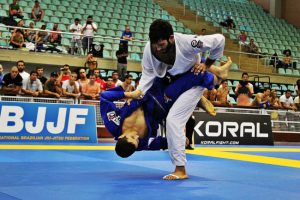By Lívia Caroline Neves | Translation: Magali DaSilva
The origin of Jiu-Jitsu has been lost across the ages. It’s thought that the first time a human being attacked or defended him/herself, that was the first real fight. It’s obvious that the instinct of attack or self-defense is latent in the human being, otherwise we wouldn’t have survived prehistoric times. The control and molding of this aggressiveness, and the respect for Nature’s Laws, resulted in the creation of the Martial Arts.
Among the existing Martial Arts, Jiu-Jitsu is one of the subtlest. The study of the human anatomy and its weak spots, the use of leverage, of physics principles and flexibility, in harmony with the mind, result in one of the most refined arts. As a basic principle, Jiu-Jitsu uses a minimum of strength. For a good result, a fighter takes advantage of the opponent’s strength as well as his/her weakness.
According to some sources, this art originated in ancient India, especially among the Buddhist Monks, that traveled a lot and were constantly attacked by barbarians. Their religious principles did not allow them to be violent, and in order to avoid attacks, they invented a new method of defense. It was the birth of Jiu-Jitsu, whose strict translation means “Gentle Art.”
After India, China was the next one to learn about this technique, and there, it was used as a war practice, with a short kimono and free hands. As a body fight, Jiu-Jitsu was very important in the disarmament process, and its practice got to its peak during the unification of China. In Japan, Jiu-Jitsu evolved and was divided into many styles. But it was from Brazil, that it reached the world, spontaneous and naturally. Today, this martial art of subtle movements is one of the greatest means of divulging Brazilian culture.
Jiu-Jitsu arrived in Brazil in the beginning of the XX century, brought by Mitsuyo Maeda, a Japanese immigration chief officer. Maeda taught his skills to Carlos Gracie, deceased, elder brother of Helio Gracie, one of the main responsible for making this art known in Brazil, and now also in the world. Carlos Gracie arrived in Rio de Janeiro in 1925. Founded the first Jiu-Jitsu academy at Marquês de Abrantes Street, in the Flamengo neighborhood, where he taught his brothers George, Gastão, Oswald and Helio.
Hélio Gracie became the big name and disseminator of this martial art, and the city of Rio de Janeiro became known as the Jiu-Jitsu Mecca, for having concentrated the entire Gracie family, that, since then, has extremely improved the sport. Many disciples graduated. Besides Hélio Gracie, other known Gracie family members were Carlson and Rolls Gracie. Rorion, Renzo, Royler, Royce and Rickson are part of Gracie’s family that are among the best fighters in the world.
Jiu-Jitsu’s first institution in Brazil was Federação Carioca de Jiu-Jitsu, founded by Hélio and later managed by Robson Gracie. Currently, there is the Brazilian and the World Confederation, both run by Carlos Gracie Jr, the American Federation of Brazilian Jiu-Jitsu, run by Joe Moreira and the International Gracie Jiu-Jitsu Federation created with the support of master Helio Gracie. Jiu-Jitsu may be considered the mother of all other martial arts.
Other categories of competition sports, like karate and judo, derived from it. Jiu-Jitsu is the oldest and most perfect personal defense martial art. It is superior to all other styles because it’s the most efficient and complete. We can divide Jiu-Jitsu in 6 parts: Throws and take-downs (Judo), Kicks and Punches (Karate-Jitsu), Joint Manipulations (Aiki-Jitsu), Chokes, Immobilizations, Positioning (Combat position; the moment of attack and defense). It’s practiced standing up or on the ground, with any type of clothing.















